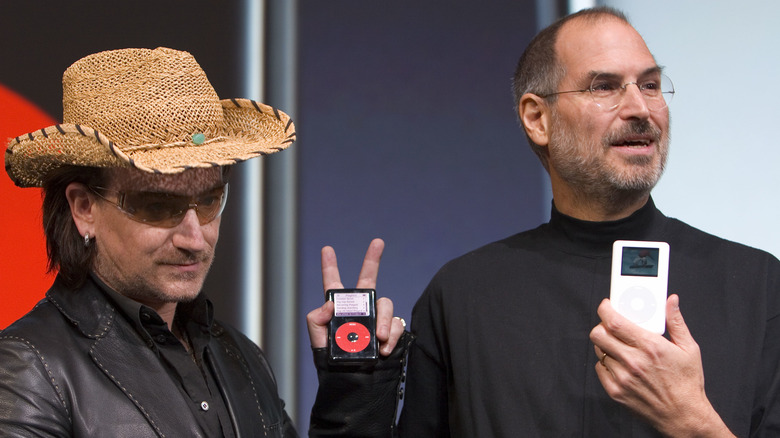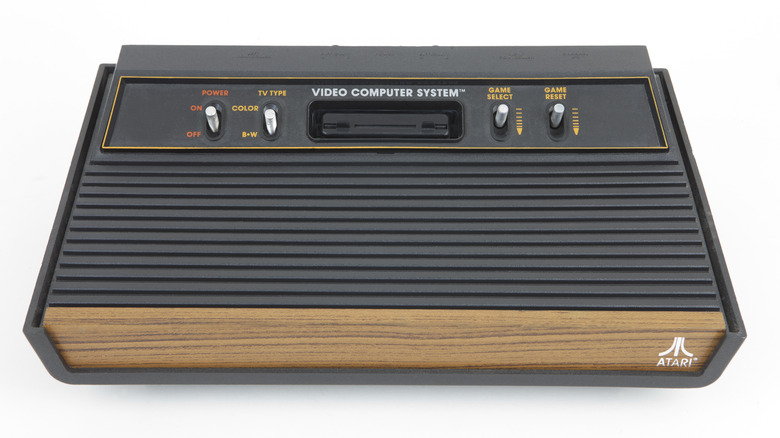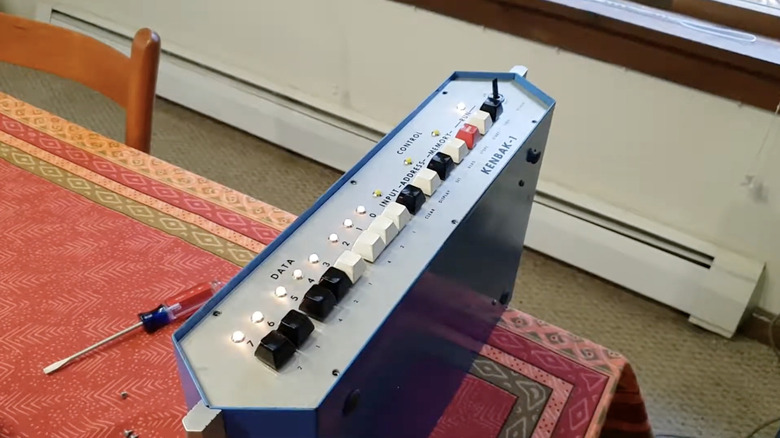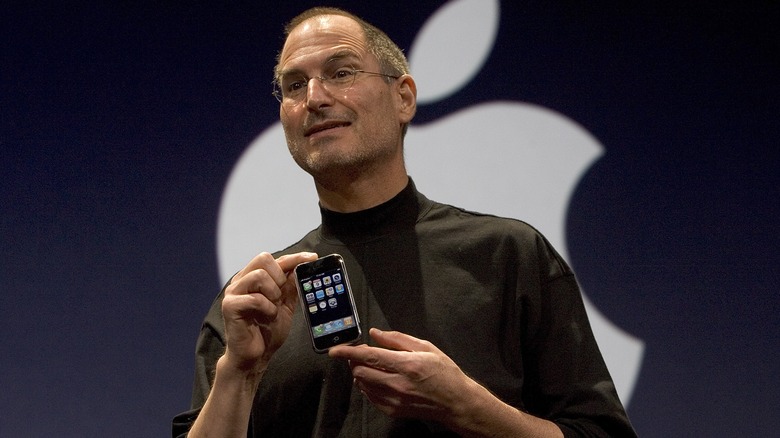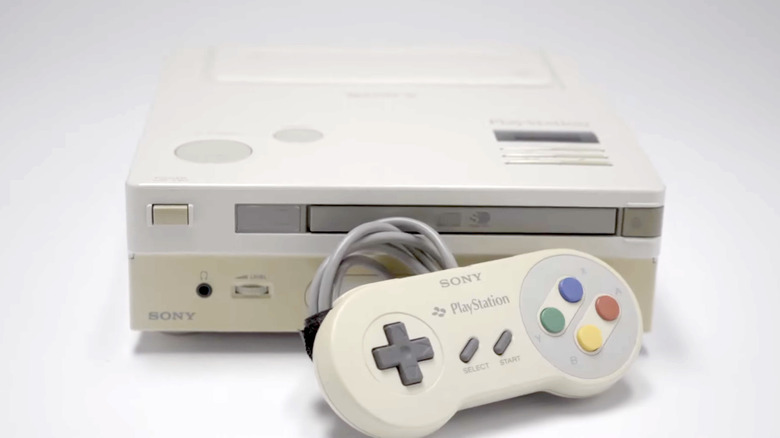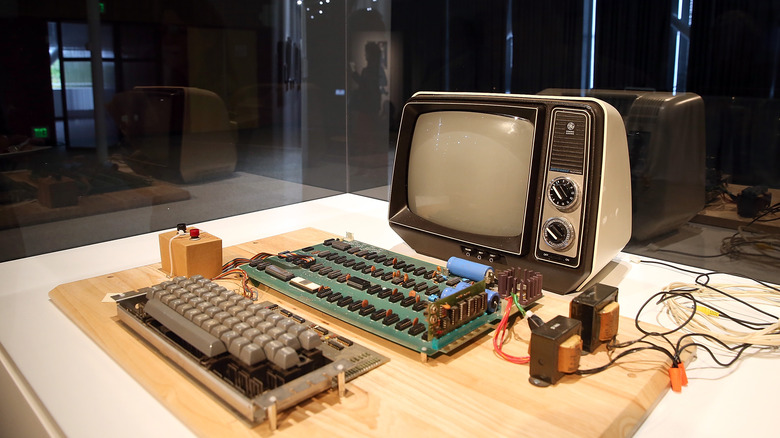6 Of The Most Expensive Old Electronics Ever Sold At Auction
It's difficult to overstate the degree to which the collectibles world has become a sellers' market in recent years, thanks in large part to a massive surge in interest during the height of the COVID-19 pandemic. "Collecting provides solace and structure, and ways that we can still be productive doing something we can enjoy," explained Dr. Shirley Mueller MD, a psychiatrist and expert in the psychology of collecting, in a November 2020 Smithsonian Magazine article. "Collecting is also about control. We can control our collections. We can't control Covid." In addition, finding your preferred collectibles and researching them is easier than ever before thanks to the internet. Everything from toys, comic books, trading cards, and records to less conventional fare like rare consumer electronics are ripe for being scooped up by the right collector with the right offer.
Over the years, some pieces of old electronics in particular have sold for significant sums of money at auction. Apple has a dedicated fanbase and history with clear milestones that makes certain products ideal collectibles for those who can afford them, so its most desirable wares have repeatedly fetched a pretty penny. In the video game world, storied prototypes of unreleased hardware have gone for tens or even hundreds of thousands of dollars, as well, with the price going up for the rarest items with the juiciest stories behind them, and the earliest personal computers have also fetched similar sums. Let's look at some of the most lucrative such auctions to date.
iPod 4th Generation U2 Edition
The iPod was not the first portable music player capable of playing back MP3s and similar lossy-encoded audio files. However, the early devices that started hitting stores in 1998 just didn't make sense as far as the value proposition went, with reasonably-priced solid-state flash storage topping out at 32MB or sometimes 64MB, barely enough for an album or two. As flash players hit the 128MB mark, Apple countered with the first iPod for $400 in 2001, with 5GB of storage on a special Toshiba-made 1.8-inch hard drive.
This changed the game and paved the way for Apple's dominance in the space. The HDD iPod, eventually renamed the iPod Classic, was discontinued in 2014 when, per Apple CEO Tim Cook, they couldn't get the necessary parts anymore, presumably referring to Toshiba's 1.8-inch miniaturized hard drives being taken out of production.
Along the way, the iPod Classic had a slew of different variations and updates, including a few special editions. Perhaps most memorably, in 2004, Apple unveiled a U2-themed limited edition, complete with etched facsimiles of the autographs of all four members of the legendary band. With Apple and U2 memorabilia both having significant collector communities, the best exemplars of the U2 iPod fetch a pretty penny. Perhaps unsurprisingly, the most it sold for was in the immediate aftermath of the iPod Classic being discontinued, with a sealed U.K. release of the U2 version of the fourth-generation iPod closing at $90,000 in a December 2014 eBay auction.
Atari CX3000 Graduate Computer Keyboard prototype
For younger people, it can be hard to grasp just how fractured the personal computer market was in the 1980s. For as long as many people reading this have been alive, the market consisted almost entirely of Windows computers from a slew of manufacturers, Apple's Mac line running its in-house operating system, and Google's Chrome OS flavor of Linux also gaining ground in recent years.
In the '80s, the landscape was completely different, with all sorts of completely different computers from numerous rival manufacturers that weren't working on a common standard. During this time, one of the major players was Atari, which balanced its video game console business with a line of personal computers. At times, Atari attempted to make the two product lines intersect, like with the Graduate Computer, a keyboard kit meant to convert the Atari 2600 into a very basic starter computer.
Atari keyboard, the first universal remote (designed my Steve Wozniak), the first apple mouse, and the first mouse from, like, the late 60s. pic.twitter.com/hGsSXHP0nF
— JohnRiggs (@johnblueriggs) September 29, 2024
That project was canceled in September 1983, though, making all prototypes of the CX3000 Graduate Computer particularly rare. Sure enough, one such prototype showed up on the block for RR Auctions in March 2023. "This Graduate, which was earlier briefly promoted by Atari as 'My First Computer,' originates from the personal collection of an Atari program manager, who was part of the team that presented this prototype privately to key accounts at the Consumer Electronics Show (CES) in Las Vegas in January 1983," reads the auction listing. Bidding closed at $61,141, more than 40x the $1,500 estimate.
Kenbak-1
Though the Apple I is probably the earliest personal computer most people reading this have ever heard of, it was not the first PC of any kind. If various computing museums are to be believed, that honor goes to the Kenbak Corporation's Kenbak-1. Released in 1971, just 50 units were produced, 44 of which were sold, and just 14 of the units sold are still known to exist. Though released in 1971, it was designed in 1970, so it predated the first microprocessor, meaning that it was built on an integrated circuit of transistor-transistor logic chips. It also didn't have a monitor, disk drive, keyboard, or any other modern-style input devices. Instead, switches and lights adorning the front panel were the Kenbak-1's only inputs and outputs.
Unsurprisingly, given its extreme scarcity, the Kenbak-1 has gone for serious bank when it's come up for auction in recent years. First, in September 2015, Bonhams listed one that sold for $31,250, a sum that includes the buyer premium that the auctioneer takes off the top, and just weeks later in November 2015, Auction Team Breker sold a different Kenbak-1 for €34,000 or $36,500 U.S. at the time. The biggest auction to date, though, was held by Christie's in September 2024, with that Kenbak-1 fetching a whopping $119,700. There's a good reason for that: It was part of Microsoft co-founder Paul Allen's collection, sold off after his death. The over $1.6 billion collection included not just historical computing artifacts, but also other notable inventions and various works of art.
4GB launch model iPhone
In 2007, Apple took the world by storm with the release of the original iPhone. Even in its original capacity as a carrier exclusive, it was a smash hit. How big a hit? In time, the deluge of new customers severely overburdened AT&T's network to the point of lessening the quality of service and harming the overall user experience.
However, as massively popular as the iPhone was from the jump, there was a version of the launch model iPhone that, at the time of release, was a monumental flop. When Apple released the original iPhone on June 29, 2007, it came in two different SKUs: One with 4GB of storage and another with 8GB. The 16GB model didn't launch until February 2008. With a price difference of just $100, the 8GB model outsold the 4GB version to such a degree that the lesser SKU was dropped on September 5, 2007, meaning it was sold for less than seven weeks.
This kind of flop, though, is perfect for the collectibles market, especially for the few people who, for whatever reason, manage to have it sealed in the original box. For there to be an Apple product that's simultaneously as iconic as the original iPhone and uniquely rare as the 4GB SKU makes it uniquely scarce and desirable. In July 2023, a 4GB iPhone sold for $190,000 at LCG Auctions, while another 4GB iPhone was listed there three months later and eventually sold for over $133,000.
Nintendo PlayStation
Though Sony took the video game world by storm when it threw its hat in a then-crowded console race with the 1994 launch of the PlayStation 1, it technically wasn't Sony's first PlayStation or even Sony's first video game console. In the pile of failed Sony media formats that the Japanese company has pushed over the years, the first gaming-related effort was attempting to create an open standard, Compact Disc-Interactive, with Philips. However, it flopped without much buy-in from other electronics companies.
While CD-i hit the market as a primarily Philips-branded entity, Sony and Nintendo announced a partnership on a CD-ROM drive for the Super Nintendo Entertainment System console and a Sony-made all-in-one box, the PlayStation. Nintendo, regretting the terms of the deal with Sony, quickly reversed course and went all-in with Philips, instead. This angered Sony and sent the electronics giant into action to make a PlayStation on its own, all as revenge for a console that never ended up coming out.
In 2020, right before COVID-19 lockdowns changed life as we knew it, a Nintendo PlayStation prototype was listed at Heritage Auctions. This specific instance, originally owned by Sony Computer Entertainment CEO Olaf Olafsson, was already known to exist, but with the CD-ROM drive in a non-functional state. In the years since it was initially discovered, the CD-ROM drive was fully restored to working order. Bundled with a debugging cartridge necessary for it to run, it sold for $300,000 to game collector, Toys.com and Pets.com founder Greg McLemore.
Apple I
The Apple I, the first Apple computer on top of being the first Apple product period, is historically significant for various reasons. In addition to the obvious ones in the first sentence, it was one of the earliest personal computers, coming out in July 1976, and every unit was hand-built by Apple co-founder Steve Wozniak. Approximately 200 units were made, selling at $666.66 each, though they weren't ready to use out of the box. Not unlike a modern Raspberry Pi, the case, power supply, and other necessities were not included. However, the Raspberry Pi has mass-produced kits for that, though. With a potent combination of massive historical significance and extreme rarity, it's only natural that whenever an Apple I shows up at auction, it commands some serious money.
In December 2020, an Apple I, with the original box included and signed inside the lid by Wozniak, sold at RR Auction for $736,863. Also bundled with the board: The Apple Cassette Interface and a Panasonic cassette player, a Sanyo monitor, a wood-encased Datanetics keyboard, an original power, supply, and the relevant manuals. This unit also had the distinction of having recently been restored to fully-working condition. In 2021, RR Auction listed another Woz-signed Apple I, but according to a report, bidding closed at $273,202, well below the $500,000 reserve price, but the computer was eventually sold for an undisclosed amount. However, also in 2021, yet another Apple I sold for $400,000 at John Moran Auctioneers.

